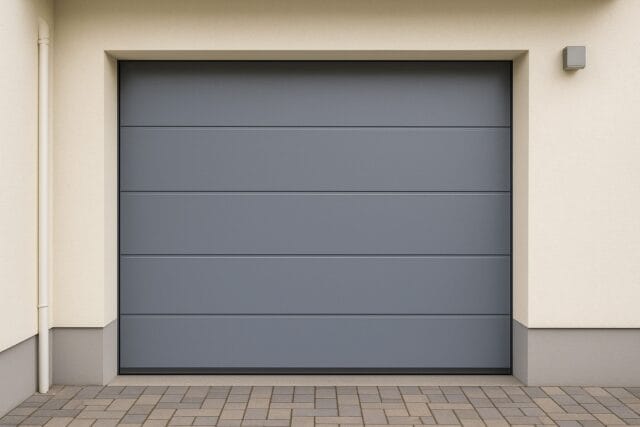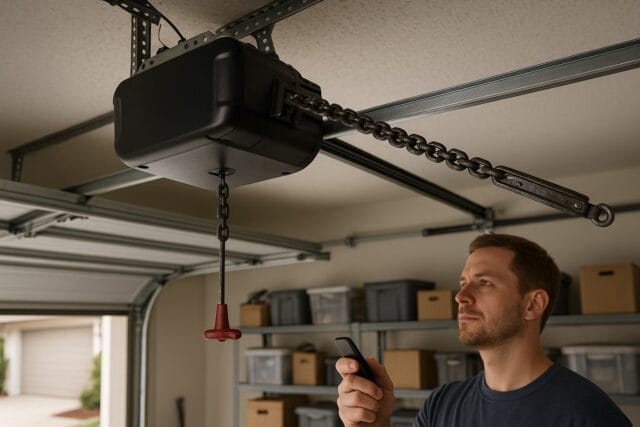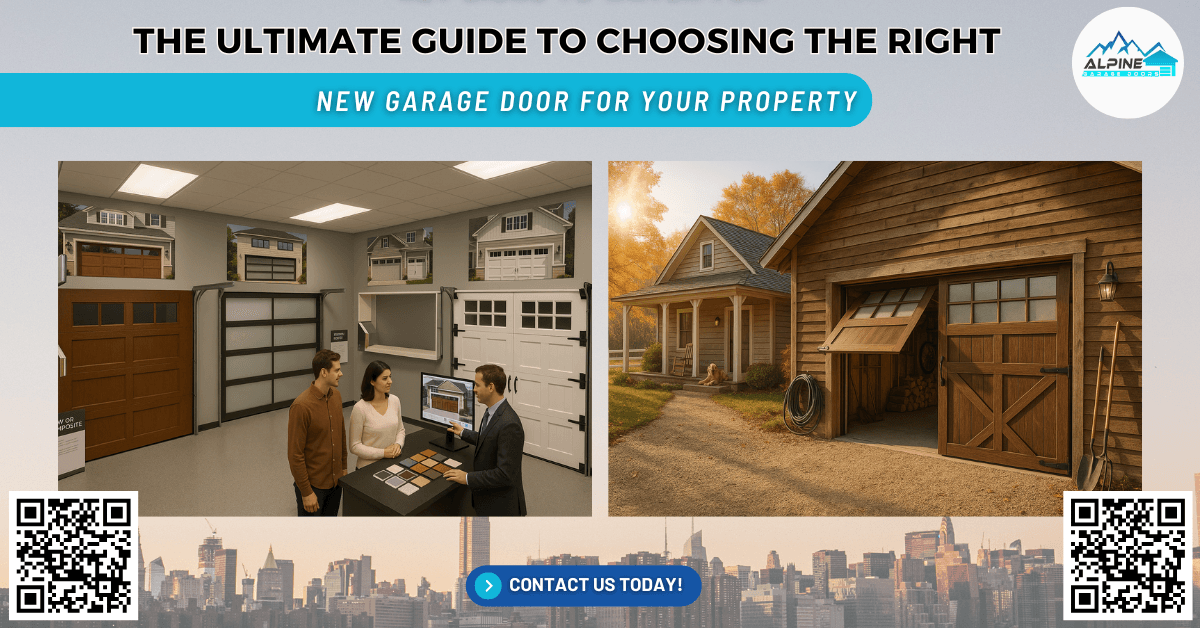Why a New Garage Door Is a Smart Investment
One chilly winter morning, David O’Mara, a homeowner in Glastonbury, CT, called us with an urgent issue: his garage door wouldn’t open. After years of withstanding harsh New England weather, the old wood garage door had warped, and the springs had failed. The outdated opener could no longer function. After a full replacement with a new insulated steel garage door equipped with a smart opener, David experienced a significant drop in heating bills and improved home security. His case illustrates how upgrading to a new garage door isn’t merely cosmetic—it’s a vital home improvement with long-term value.
According to Remodeling Magazine’s Cost vs. Value Report, a garage door replacement offers an average ROI of over 93%, placing it among the top home remodeling projects in terms of financial return. A new garage door enhances curb appeal, increases home value, and provides better insulation and functionality. From smart garage door openers to energy-efficient materials, today’s options are packed with features that benefit both residential and commercial properties.
In this comprehensive guide, we’ll walk you through everything you need to know about choosing the right new garage door, including materials, styles, openers, pricing, and installation. Whether you’re in Boston, Hartford, or anywhere in New England, this guide is designed to help you make an informed, confident choice that meets your specific needs.
Understanding Your Garage Door Needs
Before diving into designs and materials, assess your needs thoroughly. Start by identifying the type of structure, residential or commercial, and how the garage is used. Do you use the garage to store vehicles, work on DIY projects, or house sports equipment? Is it attached to your home, potentially affecting indoor temperatures? These details help determine the necessary insulation level, material durability, and operational convenience.
For example, if your garage is attached to your house and doubles as a home gym, you’ll want a well-insulated door with a high R-value to maintain comfortable temperatures. On the other hand, if it’s a detached garage used mainly for storage, you may prioritize cost over insulation. Frequent users should consider advanced safety features and a durable opener, while occasional users may need only basic functionality.
Understanding your specific use case helps you prioritize features and avoid unnecessary expenses, ensuring that your investment truly meets your day-to-day requirements.
Types of Garage Doors
Garage doors come in various styles, each offering distinct functionality, aesthetics, and space considerations. Here’s an in-depth look at the most popular types:
- Sectional Garage Doors: These are the most common in American homes. Made of horizontal panels connected with hinges, sectional doors open vertically and rest parallel to the ceiling. They are versatile, compatible with most openers, and available in insulated versions for energy efficiency. Ideal for standard garages, they balance function and style. These doors are often preferred due to their wide range of design options and reliability across various home styles.

- Roll-Up Garage Doors: Typically used in commercial environments, roll-up doors consist of narrow steel slats that roll into a coil above the opening. They are highly durable, space-saving, and excellent for high-traffic areas or warehouses. Their industrial-grade construction can handle heavy use and weather exposure. Homeowners with minimal ceiling space may also find roll-up doors practical.
- Side-Hinged Garage Doors: These open outward from a central hinge, resembling French doors. A great option for older homes or garages lacking overhead space. While they may require more clearance in front, their easy manual operation and traditional charm appeal to many homeowners. They are especially useful for garages used as storage or workshops where full access to the interior is needed.
- Slide-to-Side Garage Doors: These doors slide along a lower track to rest parallel to the wall. They’re perfect for garages with low ceilings or obstructions overhead. Though less common, they are making a comeback in modern architecture due to their unique movement and space efficiency. These doors also allow partial opening, offering better pedestrian access.
- Tilt-Up Garage Doors: A single solid panel that lifts outward and upward. Available in canopy and retractable versions, these doors offer a classic appearance but may not be ideal for short driveways due to their outward swing. They are typically more affordable but lack the energy efficiency of newer sectional styles.
Choosing the right door style involves evaluating the structure, available space, usage patterns, and aesthetic preferences. Always consult a professional if you’re unsure which type best suits your garage.
Garage Door Materials: What’s Best for Your Property?
Selecting the right material is critical because it affects not only the appearance of your garage but also its durability, maintenance requirements, and energy efficiency. Here’s a deeper dive into common materials:
- Steel: Steel garage doors are durable, versatile, and affordable. They come in a wide range of colors, finishes, and styles, including faux wood textures. Steel doors can be insulated to improve energy efficiency and noise reduction. Heavier-gauge steel offers better impact resistance. These are great for homeowners who want a strong, low-maintenance option that can handle harsh weather. Steel is also resistant to cracking and delaminating, offering long-term performance.
- Wood: Wooden garage doors provide a classic, high-end look that’s unmatched in beauty. They can be custom-built to match your home’s architecture. However, they require regular maintenance like staining or painting to protect against warping, rotting, or insect damage. Best suited for those prioritizing aesthetics over convenience. Wood is ideal for craftsman-style or traditional homes seeking a custom garage door design.
- Aluminum: Lightweight and resistant to rust, aluminum doors are often used in modern designs. They’re particularly effective in coastal regions where humidity and salt can corrode other materials. However, aluminum is prone to dents and may not offer the best insulation without added thermal breaks. They pair well with glass panels for a sleek, contemporary look.
- Vinyl: Known for being low-maintenance and durable, vinyl doors resist dents, cracking, and rust. They’re ideal for busy families or homes with children due to their resilience. Available in fewer styles and colors, but they last long with minimal care. Vinyl is also resistant to fading and moisture, making it suitable for damp climates.
- Fiberglass: Offers the look of wood without the upkeep. Fiberglass doors are light and resistant to salt air, making them suitable for coastal homes. However, they may become brittle over time in extremely cold climates. While not as common as other materials, fiberglass provides a cost-effective alternative for those seeking a balance between style and function.
- Composite: Made from recycled wood fibers and resin, composite doors deliver the charm of wood with the strength of steel. They’re insulated, low-maintenance, and eco-friendly—an excellent all-around choice. Composite materials are also resistant to rot and insects, and they perform well in a range of weather conditions.
When choosing a material, consider your region’s climate, your aesthetic preferences, and how much maintenance you’re willing to perform.
Garage Door Insulation: The Role of R-Value and Energy Efficiency
Insulation is a crucial factor, particularly for homes in regions with extreme temperatures like New England. An insulated garage door helps maintain a consistent indoor climate, especially if your garage is attached to your house or used as a living or working space. This can translate into noticeable energy savings and enhanced comfort.
R-value is the term used to measure insulation effectiveness; the higher the R-value, the better the door’s ability to resist heat flow. For garages that are used frequently or house temperature-sensitive items, an R-value between 12 and 18 is recommended. Higher-end models, like those from Wayne Dalton or Overhead Door, may exceed R-20.
Besides improving energy efficiency, insulated garage doors are also quieter and more durable. Triple-layer doors, which consist of steel, insulation, and another steel or composite back layer, offer superior strength and performance. Whether you’re dealing with cold winters or hot summers, an insulated garage door ensures optimal protection and performance.
Safety and Security Features
Safety is one of the most critical aspects of any garage door system. Modern garage doors come equipped with advanced safety and security features designed to protect your home, family, and belongings.
- Auto-Reverse Mechanism: This essential feature detects obstructions in the door’s path and automatically reverses direction. It prevents accidents involving children, pets, or vehicles and is now a required standard on all new openers.
- Photo-Eye Sensors: These sensors sit a few inches off the ground on either side of the door and stop it from closing if an object interrupts the beam. It’s a crucial safety feature for households with children and pets.
- Manual Release Handles: These allow you to manually open or close the door in the event of a power outage. This feature is especially important for garages used as entry points into the home.
- Rolling Code Technology: Garage door openers with this feature generate a new code every time you open the door, making it nearly impossible for thieves to gain access using code-grabbing devices.
- Security Cameras and Smart Alerts: Some smart openers include built-in cameras and two-way communication, so you can monitor and control garage access from your smartphone. Brands like LiftMaster and Chamberlain offer top-rated options.
Investing in these safety features provides peace of mind and ensures your garage functions as a secure, reliable entry point for years to come.
Garage Door Openers
A garage door opener is more than just a convenience—it’s a vital component of your overall system, impacting both functionality and security. Selecting the right opener depends on several factors, including the size and weight of your door, your tolerance for noise, and whether you want smart features.
- Chain Drive Openers: These use a metal chain to lift and lower the door. They’re strong, affordable, and reliable, making them ideal for heavy or oversized doors. However, they tend to be noisy and are best suited for detached garages where noise isn’t a concern.

- Belt Drive Openers: These operate similarly to chain drives but use a rubber belt instead. They’re much quieter and ideal for garages attached to living spaces. Belt drives are slightly more expensive but worth the investment for homeowners prioritizing quiet operation.
- Screw Drive Openers: These use a threaded steel rod to move the trolley. With fewer moving parts, they require less maintenance and perform well in moderate climates. However, they may struggle in extreme cold, which makes them less ideal for New England winters.
- Wall-Mounted (Jackshaft) Openers: Installed beside the garage door rather than on the ceiling, these openers free up overhead space and are perfect for garages with high ceilings or car lifts. They’re compatible with smart home systems and offer sleek, modern functionality.
- Smart Garage Door Openers: These connect to your Wi-Fi network and allow you to monitor and operate your garage door remotely via smartphone apps. Features often include scheduling, voice control, and integration with security systems. Brands like myQ, LiftMaster, and Genie offer industry-leading options.
When choosing an opener, consider horsepower requirements (1/2 HP for single doors, 3/4 HP or more for double or insulated doors), battery backup, and compatibility with existing systems. An improperly matched opener can shorten the lifespan of your garage door system.
Installation Costs and Budgeting
Understanding the cost structure of a garage door replacement helps you plan your project more effectively. Costs can vary significantly based on the size of the door, materials, style, insulation, opener type, and labor involved.
- Garage Door Price: Standard steel doors may start at $750–$1,500, while custom wood or composite doors can exceed $4,000. Carriage house styles and doors with windows or decorative features will cost more.
- Garage Door Opener: Add $200–$600 for a new opener, depending on type and features. Smart technology and camera integration may add to the price.
- Installation Labor: Professional installation typically costs $300–$1,000, depending on complexity, removal of the old door, and setup of new systems. Complex installations with structural changes or reinforcements can raise labor costs.
- Additional Features: Insulation, custom paint, or smart technology can add another $100–$1,000. Always consider the long-term energy savings of insulated doors when budgeting.
To ensure accurate pricing, request multiple quotes and be sure the estimate includes removal, disposal, permits, warranties, and post-installation cleanup. Professional installation also ensures warranty coverage and safe operation.
Garage Door Maintenance Tips
Regular maintenance is essential to keep your garage door running smoothly, extend its lifespan, and prevent costly repairs. A well-maintained door can last 15 to 30 years or more, depending on the material and usage.
- Lubricate Moving Parts: Apply garage door lubricant to rollers, hinges, tracks, and springs every six months to reduce wear and prevent noise.
- Inspect for Damage: Check panels for dents, rust, or warping. Wooden doors should be inspected for cracks, rot, or signs of insect damage. Aluminum and fiberglass may show wear differently, such as corrosion or delamination.
- Test Safety Features: Confirm that the auto-reverse mechanism and photo-eye sensors are working properly. Place a roll of paper towels under the door to ensure it reverses upon contact.
- Check Weatherstripping: Replace cracked or brittle weather seals at the bottom of the door to improve insulation and block debris or pests.
- Tighten Hardware: Screws, bolts, and brackets may loosen over time. Check and tighten hardware to prevent misalignment and unnecessary wear.
Annual inspections by a professional can help detect spring fatigue, balance issues, and worn components before they lead to breakdowns. Preventive maintenance is always more cost-effective than emergency repairs.
Final Thoughts
Choosing a new garage door is a major investment that blends aesthetics, safety, functionality, and efficiency. With so many styles, materials, and smart features available, it’s essential to assess your specific needs, budget, and preferences. From enhancing curb appeal to improving energy efficiency and home security, the right garage door delivers lasting value.
Whether you want a charming carriage house look, a sleek modern door, or a robust commercial roll-up, take the time to explore all your options. Don’t forget to factor in insulation, opener compatibility, safety features, and maintenance needs. An informed decision will not only protect your property but also elevate its appearance and performance for years.
How Can Alpine Garage Doors New England Help You?
At Alpine Garage Doors New England, we’re passionate about helping homeowners and businesses find the perfect garage door solution. With years of hands-on experience, our trained technicians offer expert advice, quality garage door installations, and dependable repairs tailored to your unique needs.
We provide:
- Free on-site consultations and estimates
- A wide selection of styles, materials, and garage door openers
- Professional installation and removal of old doors
- Maintenance plans and 24/7 emergency service
- Expertise in smart garage technology, custom doors, and energy-efficient upgrades
Whether you’re replacing an old, worn-out door or installing a brand-new design, our team is here to make the process smooth, transparent, and satisfying.
Call us today at (617) 865-7222 or visit us at 150 Cross St, Boston, MA 02109 to schedule your free consultation.
📞 Alpine Garage Doors New England – Trusted. Local. Reliable.
Your home deserves a garage door that works beautifully and lasts for years to come.
Frequently Asked Questions (FAQs)
1. How long does it take to install a new garage door?
Most professional installations take between 3 to 6 hours, depending on door size, type, and whether an opener is being installed or replaced.
2. Can I replace just one section of my garage door?
Yes, if the damage is localized and the door model is still manufactured, but full replacement may be more cost-effective for older doors.
3. Do garage doors require a permit for installation?
In many municipalities, a permit is required for garage door replacement; always check local building codes or ask your installer.
4. What is the lifespan of a garage door spring?
Torsion springs typically last 7–10 years or about 10,000 cycles; frequent use can reduce this timeframe.

